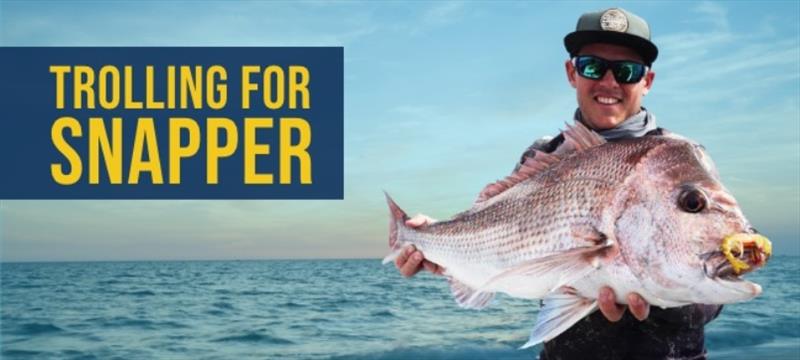
Trolling for snapper - getting started
by The Tackle Warehouse 5 Aug 2022 05:41 UTC

Trolling for snapper © The Tackle Warehouse
Although trolling for snapper isn't a new method of targeting snapper by any stretch, it definitely is an underutilised technique and is perfect for covering new or changed ground to find feeding fish.
If you are going to reacquaint yourself with your local snapper population using this technique, it's important that you have the right tools for the job! Luckily we've outlined exactly what you need below!
The Right Rods
When trolling for snapper it's good to look for rods in the 2.1-2.4m range. A fast action, graphite rod will give you plenty low end grunt to to stop angry snapper close to structure and the longer rod allows your lure to really bang around structure on the right angle to minimise snagging up. It's worth noting that the strike and initial run from a snapper when trolling can be really jarring to say the least, but having the right rod for the job will give you confidence to handle most situations.
The Right Reel and Line
Like most other snapper techniques you can fish with reels in the 2500-5000 size range pretty comfortably. That being said, if you plan to do a lot of trolling for snapper, it is worth considering a move up to a larger reel sizes to allow you to run more braid and also let more line out to get your lures to depth when fishing deeper zones.
Braided line in the 15-30lb range is ideal for most situations when trolling for snapper. It's also worth considering using a colour coded braid to help you identify how far behind your boat or kayak you need to fish to get your lures to depth.
Like always, if you go lighter you will give yourself a better chance of getting that elusive bite, but bycatch like trevally and mackerel can be costly if you fish too light so be warned!. Likewise it's also good to run 1m of good flurocarbon leader in the 20-30lb range for most situations to give you a chance in rough terrain as well as handle any snapper that manage to engulf your lure and wear away your leader on their teeth.
Although not sharp like mackerel, wahoo or sharks, snapper teeth are still very abrasive and will make light work of undersized leader, especially under strain.
Best Lures to start with
When it comes to lure choice, it's important to have a selection of options available to you to try and match local forage species in the area you are going to target. It's also worth finding some lure options that have a good action at slow speeds.
Most of your trolling for snapper will be done pretty slowly (4-5 knots) so it's important that your lure options can be fished effectively at slower speeds. Some of the teams favourites are the Nomad DTX100mm, Atomic Hardz Shiner 85 Double Deep and Rapala XRMAG and the Samaki Redic DS80/90 range
Time to re-learn your favourite spots
Now that you have the right rods, reels, line and lures it's time to re-learn your local snapper grounds! With the recent heavy rains around the country and most of the bays and river mouths getting a good flush out, trolling offers keen anglers a great way to feel their way around their favourite spots and find where feeding snapper are holding. It's still as important as ever to take your time to sound out your favourite bommie or rock clusters first to identify potential active snapper before you start blindly trolling.
Once you've done some passes and sounded some decent structure that looks to be holding fish you can start doing some investigative passes to ensure you can get your chosen lures down to depth. Most deep diving crank style lures used for targeting snapper have a bib first stance when trolled which allows you to bounce your lure over rocks and bombies relatively safely and snag free. It's worth running two options when trolling these areas so that you can have a deeper and mid water option.
Although banging your lure over structure is a great way to elicit an angry reaction bite, it's also a known fact that inquisitive snapper will also swim up through the water column to hit a lure that's presented mid water.
Go get it!
Now that you've got the basics, it's time to hit the water. Trolling for snapper can be one of the most exciting ways to target our favourite winter species, but it can take time to fine tune your approach. Persist with this technique and you will have a great approach that you can use when other strategies aren't working.
Once you find those fish, it's important to pay attention to tide phases, moon etc so that you can document and rinse and repeat in future sessions.
Like always if you need any further advice on targeting snapper on the troll, drop in and speak to the team and they will be able to hook you up and point you in the right direction.
If you are interested in targeting snapper using other techniques, you can also check out previous "Snapper Basics" Articles.